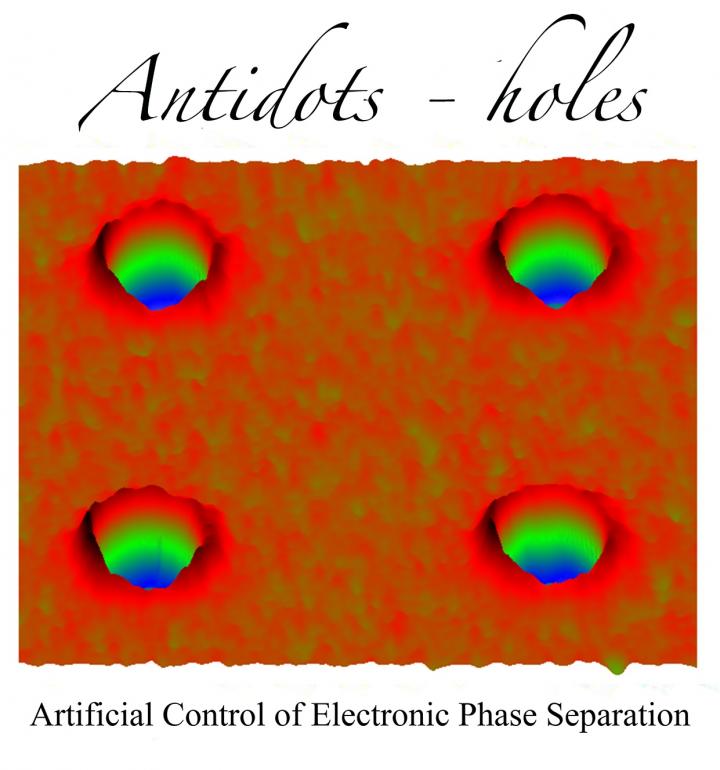New material science research may advance tech tools

LSU researchers created holes, or antidots, in thin films of manganite, which is used to build magnetic hard discs in computers. It was discovered that the edges of the antidots were magnetic. Credit: Ward Plummer, Louisiana State University
Researchers from LSU, Fudan University, the University of Florida and the Collaborative Innovation Center of Advanced Microstructures in Nanjing, China, conducted research on materials that separate into different regions through a process called electronic phase separation, which is poorly understood.
Their research advances the understanding of how these materials can be manipulated without having to discover new materials, change the chemical concentration or apply external magnetic fields. Their research was published in the Proceedings of the National Academy of Sciences.
The researchers manipulated a steel gray mineral called manganite, which is used to build magnetic hard discs in computers. They created holes, or antidots, in thin films of manganite. It was discovered that the edges of the antidots were magnetic.
“The discovery of the magnetic edge states on the antidots made this work possible. Nobody had ever seen this before,” said LSU Physics Professor Ward Plummer, a co-author on the study.
The magnetic phase state at the edges of the antidots raised the metal-to-insulator phase transition temperature of the manganite film. The researchers were able to replicate this through simulations.
“People have really tried to increase the temperature and reduce the operating field or tried to change the substrate or chemical composition. But we find this new approach with antidots to be quite useful,” said Jian Shen, head of the Department of Physics at Fudan University and a co-author on the paper.
“What you really would like to do is get this temperature above room temperature, so you can switch the material by using a magnetic field,” Plummer said.
###
This study is part of an on-going collaboration between Plummer and Shen. They began to work together on manganite systems with higher temperatures and lower magnetic fields in 1998 at Oak Ridge National Laboratory. This project continues with funding from the Department of Energy.
Media Contact
All latest news from the category: Materials Sciences
Materials management deals with the research, development, manufacturing and processing of raw and industrial materials. Key aspects here are biological and medical issues, which play an increasingly important role in this field.
innovations-report offers in-depth articles related to the development and application of materials and the structure and properties of new materials.
Newest articles

A universal framework for spatial biology
SpatialData is a freely accessible tool to unify and integrate data from different omics technologies accounting for spatial information, which can provide holistic insights into health and disease. Biological processes…

How complex biological processes arise
A $20 million grant from the U.S. National Science Foundation (NSF) will support the establishment and operation of the National Synthesis Center for Emergence in the Molecular and Cellular Sciences (NCEMS) at…

Airborne single-photon lidar system achieves high-resolution 3D imaging
Compact, low-power system opens doors for photon-efficient drone and satellite-based environmental monitoring and mapping. Researchers have developed a compact and lightweight single-photon airborne lidar system that can acquire high-resolution 3D…





















